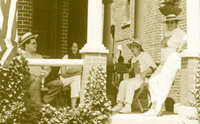| A CHECKLIST FOR CHANGE | |||||
|
GROWING INWARD REBUILDING THE CENTER CITY |
|
     
|
|
||||||||||||||||||||||||||
Little things matter. Broken or missing sidewalks, vandalized property, broken windows and litter create a negative image in the minds of residents and visitors to a city. Once formed, that image is almost impossible to change. Columbus must promote public and private efforts to address small issues in the downtown and city neighborhoods before they become problems that lead to disinvestment. Helping a community means getting people to feel they have a stake in it.
George Kelling and Catherine Coles stated the case well: "Left unrepaired, little things like unkempt property, litter, graffiti and vandalism lead to deterioration of a community. Cooperative efforts of police officers and community residents can help improve communities and restore trust. Cities that have adopted the idea (fixing broken windows) have found it a successful tool for reducing crime and revitalizing neighborhoods."
For speaker John Bryant, efforts such as these are not just busywork, they are essential: "Surviving is simply not enough anymore. We must create a while new class of stakeholders and shareholders in the American dream. It involves development of responsible and committed stakeholders capable of crossing over and superseding the cultural, racial and social lines that separate us." |
|||||||||||||||||||||||||||
| Back: Promote Historic Preservation | |||||||||||||||||||||||||||
| Introduction | Conclusion
| Speakers
| Sponsors Vision | Downtown | Policy | Transportation | Housing | Education Refocus Incentives Where Needed | Promote Historic Preservation | Evaluate Private Investment Decisions |
|||||||||||||||||||||||||||

